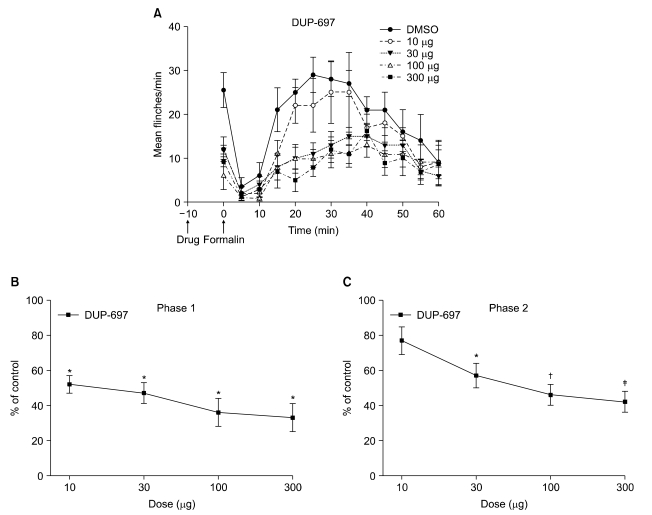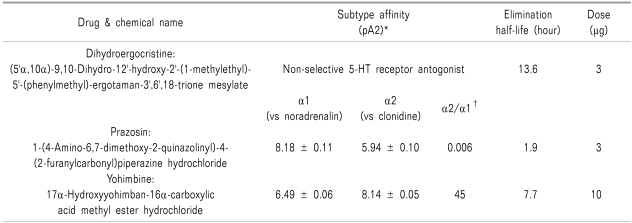1. Beiche F, Scheuerer S, Brune K, Geisslinger G, Goppelt-Struebe M. Up-regulation of cyclooxygenase-2 mRNA in the rat spinal cord following peripheral inflammation. FEBS Lett. 1996; 390:165–169. PMID:
8706851.

2. Choi CH, Kim WM, Lee HG, Jeong CW, Kim CM, Lee SH, et al. Roles of opioid receptor subtype in the spinal antinociception of selective cyclooxygenase 2 inhibitor. Korean J Pain. 2010; 23:236–241. PMID:
21217886.

3. Hamza M, Dionne RA. Mechanisms of non-opioid analgesics beyond cyclooxygenase enzyme inhibition. Curr Mol Pharmacol. 2009; 2:1–14. PMID:
19779578.

4. Marlier L, Teilhac JR, Cerruti C, Privat A. Autoradiographic mapping of 5-HT1, 5-HT1A, 5-HT1B and 5-HT2 receptors in the rat spinal cord. Brain Res. 1991; 550:15–23. PMID:
1832328.

5. Hösli E, Hösli L. Evidence for the existence of alpha- and beta-adrenoceptors on neurones and glial cells of cultured rat central nervous system--an autoradiographic study. Neuroscience. 1982; 7:2873–2881. PMID:
6296724.

6. Fürst S. Transmitters involved in antinociception in the spinal cord. Brain Res Bull. 1999; 48:129–141. PMID:
10230704.
7. Sandrini M, Vitale G, Pini LA. Effect of rofecoxib on nociception and the serotonin system in the rat brain. Inflamm Res. 2002; 51:154–159. PMID:
12005206.

8. Taiwo YO, Levine JD. Prostaglandins inhibit endogenous pain control mechanisms by blocking transmission at spinal noradrenergic synapses. J Neurosci. 1988; 8:1346–1349. PMID:
2833584.

9. Yaksh TL, Rudy TA. Chronic catheterization of the spinal subarachnoid space. Physiol Behav. 1976; 17:1031–1036. PMID:
14677603.

10. Choi JI, Yoo KY, Yoon MH. Effect of serotonergic receptors on the antinociception of intrathecal gabapentin in the formalin test of rats. J Korean Pain Soc. 2002; 15:19–25.
11. Coppi G. Dihydroergocristine. A review of pharmacology and toxicology. Arzneimittelforschung. 1992; 42:1381–1390. PMID:
1492857.
12. Grognet JM, Rivière R, Istin M, Zanotti A, Coppi G. The pharmacokinetics of dihydroergocristine after intravenous and oral administration in rats. Arzneimittelforschung. 1992; 42:1394–1396. PMID:
1492859.
13. Doxey JC, Roach AG, Smith CF. Studies on RX 781094: a selective, potent and specific antagonist of alpha 2-adrenoceptors. Br J Pharmacol. 1983; 78:489–505. PMID:
6132640.

14. Hamilton CA, Reid JL, Vincent J. Pharmacokinetic and pharmacodynamic studies with two alpha-adrenoceptor antagonists, doxazosin and prazosin in the rabbit. Br J Pharmacol. 1985; 86:79–87. PMID:
2864970.

15. Hubbard JW, Pfister SL, Biediger AM, Herzig TC, Keeton TK. The pharmacokinetic properties of yohimbine in the conscious rat. Naunyn Schmiedebergs Arch Pharmacol. 1988; 337:583–587. PMID:
3412496.

16. Yoon MH, Choi JI, Jeong SW. Spinal gabapentin and antinociception: mechanisms of action. J Korean Med Sci. 2003; 18:255–261. PMID:
12692425.

17. Puig S, Sorkin LS. Formalin-evoked activity in identified primary afferent fibers: systemic lidocaine suppresses phase-2 activity. Pain. 1996; 64:345–355. PMID:
8740613.

18. Nishiyama T. Analgesic effects of intrathecally administered celecoxib, a cyclooxygenase-2 inhibitor, in the tail flick test and the formalin test in rats. Acta Anaesthesiol Scand. 2006; 50:228–233. PMID:
16430547.

19. Pini LA, Vitale G, Sandrini M. Serotonin and opiate involvement in the antinociceptive effect of acetylsalicylic acid. Pharmacology. 1997; 54:84–91. PMID:
9088041.

20. Vitale G, Pini LA, Ottani A, Sandrini M. Effect of acetylsalicylic acid on formalin test and on serotonin system in the rat brain. Gen Pharmacol. 1998; 31:753–758. PMID:
9809474.

21. Courade JP, Caussade F, Martin K, Besse D, Delchambre C, Hanoun N, et al. Effects of acetaminophen on monoaminergic systems in the rat central nervous system. Naunyn Schmiedebergs Arch Pharmacol. 2001; 364:534–537. PMID:
11770008.

22. Bonnefont J, Alloui A, Chapuy E, Clottes E, Eschalier A. Orally administered paracetamol does not act locally in the rat formalin test: evidence for a supraspinal, serotonin-dependent antinociceptive mechanism. Anesthesiology. 2003; 99:976–981. PMID:
14508334.

23. Fairbanks CA. Spinal delivery of analgesics in experimental models of pain and analgesia. Adv Drug Deliv Rev. 2003; 55:1007–1041. PMID:
12935942.

24. Xu JJ, Walla BC, Diaz MF, Fuller GN, Gutstein HB. Intermittent lumbar puncture in rats: a novel method for the experimental study of opioid tolerance. Anesth Analg. 2006; 103:714–720. PMID:
16931686.

25. Pinardi G, Sierralta F, Miranda HF. Interaction between the antinociceptive effect of ketoprofen and adrenergic modulatory systems. Inflammation. 2001; 25:233–239. PMID:
11580099.
26. Miranda HF, Sierralta F, Pinardi G. An isobolographic analysis of the adrenergic modulation of diclofenac antinociception. Anesth Analg. 2001; 93:430–435. PMID:
11473875.

27. Miranda HF, Pinardi G. Isobolographic analysis of the antinociceptive interactions of clonidine with nonsteroidal anti-inflammatory drugs. Pharmacol Res. 2004; 50:273–278. PMID:
15225670.








 PDF
PDF Citation
Citation Print
Print



 XML Download
XML Download